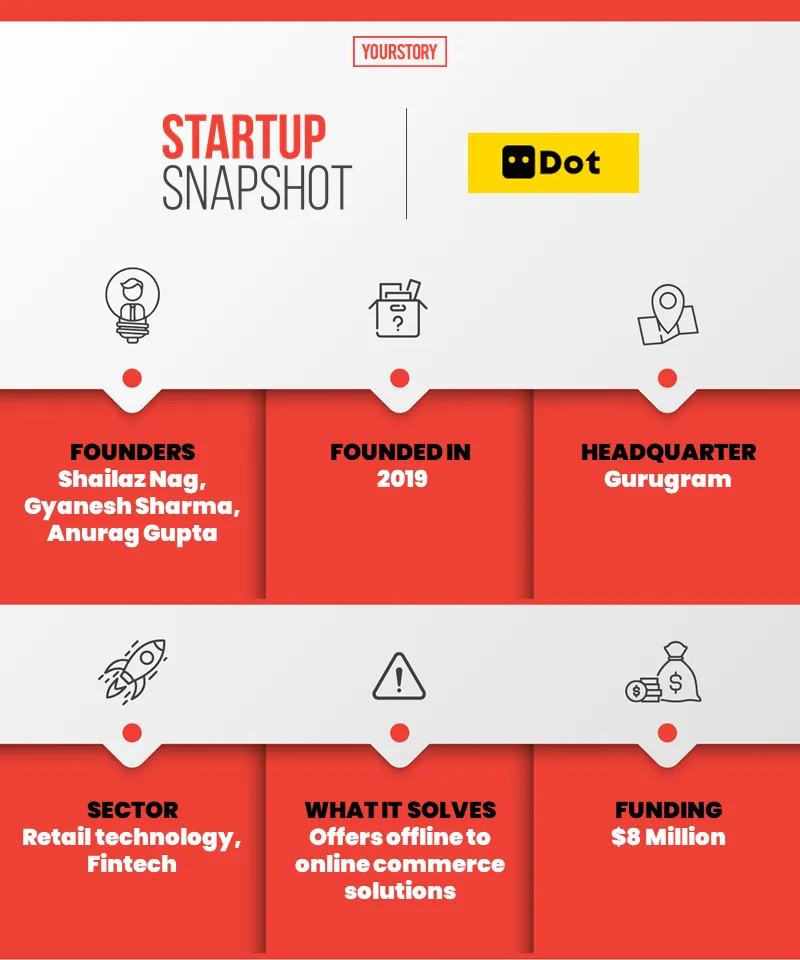Started by former PayU India colleagues, DotPe helps F&B retailers in contactless transactions
Started in 2019, Gurugram-based startup DotPe offers digital ordering solutions like QR code, and WhatsApp-based scan-order-pay features to restaurants and F&B brands.
The mandated social distancing norms in public spaces — owing to the COVID-19 pandemic — has ignited Indian startups to come up with innovative business solutions for restaurant operators and F&B retailers.
One such startup is Gurugram-based . Started in 2019 by Shailaz Nag, Gyanesh Sharma, and Anurag Gupta, the B2B2C tech startup provides neo digital transformation and commerce solutions to restaurants and F&B brands across India.
DotPe offers offline to online (O2O) based payment features which include direct communication and digital ordering solutions, QR code, and WhatsApp-based scan-order-pay features.

The retail fintech startup has collaborated with several marquee clients, including StarBucks, Big Chill, McDonald’s, Barista, Beer Cafe, and Smoke House Deli, who are utilising its solutions to connect with their consumers directly, as well as avoid long queues in the shop.
The product
DotPe Co-founders Shailaz, Gyanesh, and Anurag knew each other since their time working at PayU India. While Shailaz worked as the Co-founder and Managing Director of PayU, Gyanesh and Anurag held the positions of Head of Engineering and Head of Banking and Product Partnership, respectively.
“While building PayU India, we had the same DNA and we’re behind the merchants. We had this fundamental DNA that you can empower the merchants into their customer experience. That was the genesis of the idea,” says Gyanesh.
The trio then designed and built the product, and eventually launched DotPe in 2019.
DotPe’s platform offers a slew of digital capabilities to the traditional ‘brick and mortar’ businesses and helps them with their payment and commerce-related needs.

Image credit: DotPe
According to DotPe, this O2O model claims to be eliminating various hassles that are typical to the conventional B2C models, like doing away with app download procedures and allowing users to commence ordering by simply scanning a QR code.
Some of these features include QR-based catalogue discovery, digital ordering (both dine-in and take-away solutions), customer engagement, and online payment options to retailers.
These solutions help food courts to ensure streamlined business operations while following the social distancing norms amidst the pandemic. It also allows for minimal human touch while ordering and settling the bill, making customers feel safe in crowded places like shopping malls.
DotPe charges flat fees from merchants, reducing peoples’ reliance on various app downloads while allowing transactions for products via a simple scan of the QR code.
On the customers' front, DoptPe enables them to discover food joints directly on Google by the popularity of individual catalogue items. For further transactions, the customers can interact with these brands via WhatsApp, Facebook, SMS, and various other popular open messaging platforms.
“We are leveraging digital technologies like AI and ML on our flagship platform. The unique and state-of-the-art platform allows customers to seamlessly glide through essential trade aspects without relying on third-party tools and applications. It is a testament to the fact that the retail sector no longer has to rely on the industrial aggregator models for growth and survival in a post-COVID landscape,” says Shailaz.
The startup got its first merchant Haldiram’s, as well as raised a seed funding worth $8 million, in February 2020. The round was led by eminent investors like Naspers, Fosun Group, and Info Edge Ventures.
During the pandemic-led lockdown, it went on to forge the majority of its partnership in the retail F&B space, claiming to have over 9,000 active big and medium-scale merchants who have adopted its solutions.
Standing apart
A report by IBEF shows that the retail industry is growing at a CAGR of 13 percent since 2018, and is expected to reach $1.1 trillion by 2020.
One of the biggest challenges DotPe faced in its journey was in making a mark for itself in an evolving ecosystem that is replete with several experienced and large players.

DotPe Co-founders (L-R) Shailaz Nag, Anurag Gupta, and Gyanesh Sharma,
“Being only a seven months old company, we had to gather our best energies and resources to plan, learn, unlearn, implement, and regroup, to reach where we have currently. Though the company is certain of its pioneering payment features and digital commerce capabilities, the pandemic has brought it in close competition with a plethora of big-ticket brands in the foodtech, and fintech space, that have similar offerings,” says Shailaz.
The startup competes with the likes of and Dineout in the foodtech and in the fintech market.
However, the team believes that DotPe’s platform separates itself from the rest with its end-to-end digital capabilities.
“The USP of our offerings is that people can commence ordering easily from our platform by merely scanning a QR code. Additionally, our scan-order-pay feature is benefiting thousands of people every day by localising the service and allowing people to adhere to social distancing norms during these challenging times,” he adds.
Plans ahead
DotPe envisions to become the primary enabler and disruptor in the O2O segment by effectively blurring the line between offline and online in the near future.

A restaurant using DotPe product I Image Credit: DotPe
The startup has established a comprehensive objective plan, wherein it aspires to gain 30,000 large format and enterprise retailers, five lakh long-tail merchants, and one million daily transactions on its platform by the end of the current financial year.
It also intends to venture into sectors such as pharmacy, modern trade, and fashion, which are showing massive potential for further digital transformation.
Edited by Suman Singh










